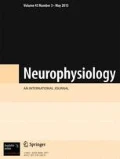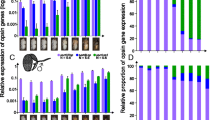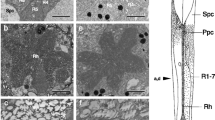Abstract
The compound eye of worker honeybees with an inborn disturbance of intermediate metabolism of tryptophan — the snow (s) and laranja (la) mutations — has increased sensitivity to light, at least 100 times higher than normal in snow and at least 10 times higher in laranja. The maxima of the spectral sensitivity curves for the whole eye in snow are shifted into the 530 nm region and in laranja to 550 nm (comparedwith 545 nm for the wild type). The electroretinograms of s andla homozygotes are unusual in form on account of the presence of a fast additional component of the receptor potential that is absent in wild-type individuals. This may be the result of immaturity of the pigment granules in the mutants, due to the inherited absence of ommochromes. Pigment granules probably play an important role not only in the formation of the light-protective screen of the ommatidium, but also in biochemical processes considered to be responsible for the electrical passivity of the photoreceptor membrane. The possibility likewise cannot be ruled out that inherited changes in the photoreceptor membranes are connected with an imbalance between derivatives of tryptophan metabolism which participate in the generation of the cell receptor potential.
Similar content being viewed by others
Literature cited
S. Benzer, "From gene to behavior," in: Current Problems in Behavioral Genetics [Russian translation], Nauka, Leningrad (1975), pp. 5–21.
J. Woyke, "The use of artificial insemination in the genetics and breeding of honeybees," in: Instrumental Insemination of Queen Bees [in Russian], Apimondia Bucharest, (1975), pp. 93–106.
F. G. Gribakin, "Investigation of spectral and polarization sensitivity of single photoreceptors of the beetleLethrus by means of an automatic substitution colorimeter," Dokl. Akad. Nauk SSSR,245, No. 2, 494 (1979).
F. G. Gribakin, "Mechanism of regulation of the light sensitivity of insect photoreceptors," in: Sensory Systems [in Russian], Nauka, Leningrad (1979), pp. 3–24.
F. G. Gribakin, Mechanisms of Photoreception in Insects [in Russian], Nauka, Leningrad (1981).
L. A. Kuz'mina, N. G. Lopatina, and V. V. Ponamarenko, "Kynurenin in hereditary disturbances of functions of the nervous system and behavior of the honeybee," Dokl. Akad. Nauk SSSR,245, No. 4, 964 (1979).
N. G. Lopatina, V. G. Marshin, I. A. Nikitina, et al., "The effect of some mutations on behavioral and neurological features of insects," Zh. Vyssh. Nerv. Deyat.,26, No. 4, 785 (1976).
N. G. Lopatina, Signal Activity in the Family of the Honeybee [in Russian], Nauka, Leningrad (1971).
L. I. Frantsevich, Visual Spatial Analysis in Insects in Russian], Naukova Dumka, Kiev (1980).
K. Frisch, From the Life of Bees [Russian translation], Mir, Moscow (1965).
E. G. Chesnokova, "Effect of the snow mutation, blocking the kynurenin pathway of tryptophan metabolism, on background bioelectrical activity of the second thoracic ganglion of honeybees," Dokl. Akad. Nauk SSSR,248, No. 6, 1460 (1979).
E. G. Chesnokova, A. D. Polyanovskii, and F. G. Gribakin, "Effect of snow and laranja mutation on the morphological characteristics of the compound eye of the honeybee," Dokl. Akad. Nauk SSSR,298, No. 4, 1350 (1981).
E. G. Chesnokova and V. V. Ponomarenko, "The study of the effect of mutant genes with a known biochemical effect on the rate of formation of motor conditioned reflexes in honeybees," Zh. Vyssh. Nervn. Deyat.,30, No. 4, 761 (1980).
H. Autrum, "The physiological basis of colour vision in honey bee," in: Ciba Foundation Symposium on the Physiology and Experimental Psychology of Colour Vision (London, April, 1965), London (1965), pp. 268–300.
H. Autrum and V. von Zwehl, "Spectrale Empfindlichkeit einzelner Sehzellen den Bienenauges," Z. Vergl. Physiol.,48, No. 6, 357 (1964).
F. Baumann, "Slow and spike potentials recorded from retinula cells of the honey bee drone in response to light," J. Gen. Physiol.,58, No. 6, 855 (1968).
I. V. Burovina, F. G. Gribakin, A. M. Petrosyan, et al., "Ultrastructural localization of potassium and calcium in an insect ommatidium as demonstrated by X-ray microprobe analysis," J. Comp. Physiol.,127, No. 3, 245 (1978).
J. H. Dustmann, "Eine chemische Analyse der Augenfarbmutanten vonApis mellifera" J. Insect Physiol.15, No. 12, 2225 (1969).
J. H. Dustmann, "Pigment studies on several eye-colour mutants of the honey bee,Apis mellifera," Nature,219, 950 (1968).
B. Fulpius and F. Baumann, "Effect of sodium, potassium, and calcium ions on slow and spike potentials in a single photoreceptors," J. Gen. Physiol.,53, No. 5, 541 (1969).
F. G. Gribakin, "Cellular mechanisms of insect photoreception," Int. Rev. Cytol.,57, No. 1, 127 (1979).
W. A. Harris, W. S. Stark, and J. A. Walker, "Genetic dissection of the photoreceptor system in the compound eye ofDrosophila melanogaster," J. Physiol. (London),256, No. 2, 415 (1976).
H. Langer, "Properties and functions of screening pigments in insect eyes," in: Photoreceptor Optics, Springer-Verlag, Berlin (1975), pp. 429–455.
R. Menzel and M. Blakers, "Color receptors in the bee eye — morphology and spectral sensitivity," J. Comp. Physiol.,108, No. 1, 11 (1976).
S. Murphy, M. G. Uzbekov, and S. P. R. Rose, "Changes in serotonin receptors in different brain regions after light exposure of dark-reared rats," Neurosci. Lett.,17, No. 3, 317 (1980).
W. L. Pak, S. E. Ostroy, M. C. Deland, and C. F. Wu, "Photoreceptor mutant ofDrosophila: is protein involved in intermediate steps of phototransduction?," Science,194, 956 (1975).
W. S. Stark, A. M. Ivanyshyn, and R. M. Greenberg, "Sensitivity and photopigments of R 1–6, a two-peaked photoreceptor, inDrosophila, Calliphora andMusca," J. Comp. Physiol.,121, No. 3, 280 (1977).
W. S. Stark and G. S. Wasserman, "Wavelength-specific ERG characteristics of pigmented- and white-eyed strains ofDrosophila," J. Comp. Physiol.,91, No. 4, 427 (1974).
R. L. Tilson, C. L. Judson, and F. E. Strong, "Electrophysiological responses in mutant-eyed drones ofApis mellifera to selected wavelengths of light," J. Insect Physiol.,18, No. 12, 1441 (1972).
R. H. White and N. A. Michaud, "Calcium is a component of ommochrome pigment granules in insect eyes," Comp. Biochem. Physiol., Ser. A,65, No. 2, 239 (1980).
J. Woyke, "Laranja: a new honey bee mutation," J. Hered.,64, No. 4, 227 (1973).
Additional information
I. M. Sechenov Institute of Evolutionary Physiology and Biochemistry, Academy of Sciences of the USSR, Leningrad. I. P. Pavlov Institute of Physiology, Academy of Sciences of the USSR, Leningrad. Translated from Neirofiziologiya, Vol. 14, No. 1, pp. 69–75, January–February, 1982.
Rights and permissions
About this article
Cite this article
Gribakin, F.G., Chesnokova, E.G. Changes in functional characteristics of the compound eye of bees caused by mutations disturbing tryptophan metabolism. Neurophysiology 14, 57–62 (1982). https://doi.org/10.1007/BF01058820
Received:
Issue Date:
DOI: https://doi.org/10.1007/BF01058820




